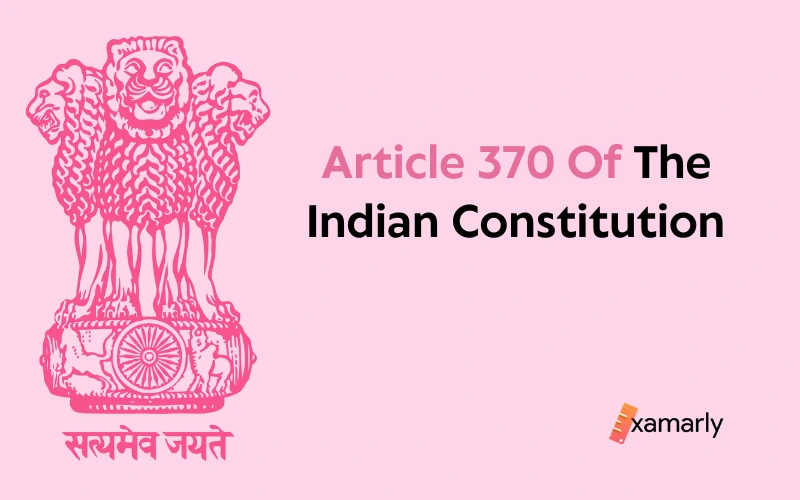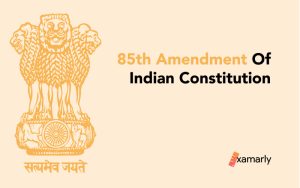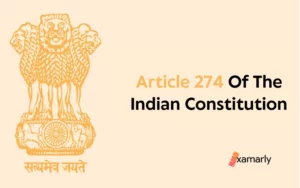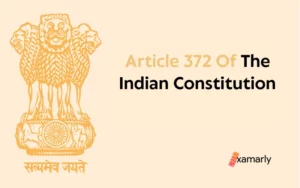Article 370 of the Indian Constitution is a provision that guarantees a certain sense of autonomy to Jammu & Kashmir and gives it a special status in terms of governance. What is meant by special status?
Article 370’s main characteristic was that the Central laws established by Parliament did not automatically apply to the erstwhile State of Jammu & Kashmir. That is, the state can have a separate constitution, flag, and autonomy in administration.
Except in terms of defense, foreign affairs, finance, and communication, this allowed the State to have complete power over 94 of the 97 items on the Union List.
Citizenship, ownership, and Fundamental Rights were all governed by different laws and rules in the state than they were in the union. Thus, the parliament’s Legislative powers were limited in the case of Jammu & Kashmir.
It is included in Part XXI of the Constitution: Temporary, Transitional, and Special Provisions. As the title of the Part indicates, it was intended to be a temporary provision, with its application expected to endure until the State’s constitution was drafted and adopted.
This essay on Article 370 will cover the historical development of the article, the presidential orders applicable to Jammu and Kashmir, how it was removed, and the current status of Jammu and Kashmir.
Article 370 of the Indian Constitution is a must-cover topic for UPSC Exam within Indian Polity. Read on to know more.
- Historical Background Of Article 370
- Was Article 370 A Temporary Provision?
- How Was Article 370 Applied?
- Presidential Order In Article 370
- Applicability of the Indian Law to Jammu and Kashmir
- Union Territory Status
- Is Article 370 Similar To A Dictatorship?
- Why Abrogation Of Article 370 Is Necessary?
- What Is Article 35a And The Status Of 35a?
- Why Is It Being Challenged?
- Conclusion
- FAQ On Article 370 of the Indian Constitution
Historical Background Of Article 370
Jammu and Kashmir are located in the northern region of the Indian subcontinent. A large portion of Kashmir has been a matter of dispute between India, Pakistan, and China.
Its identity as a princely state of British India, the accession of Jammu and Kashmir, and the war between India and Pakistan have been influential events in the history of Jammu and Kashmir. The introduction of the constitutional provision of Article 370 can be read as the culminating event in this thread of history.
1947: After India gained Independence and post the partition of India and Pakistan, J&K ruler Hari Singh decides that J&K will remain independent. However, the attack from Pakistan changes the course of events and forced Maharaja Hari Singh to sign the Instrument of Accession with the Indian Government. According to this treaty, J&K acceded to India under the condition that no constitutional action would be taken on the State without consultation.
1948: War ends with Pakistan withdrawing its forces. Even though the accession was complete, India had offered to hold a plebiscite, and if the accession was not confirmed, “we shall not stand in the way of Kashmir divorcing herself from India”. Ayyangar reaffirmed India’s commitment to the conditions and thus the creation of a separate constitution for J&K began.
1949: On 27 May1949, the Constituent Assembly approved 306A (now 370) after modifications and negotiations. On 17 October 1949, Article 370 was eventually incorporated into the Constitution by India’s Constituent Assembly.
Who drafted Article 370 of the Indian Constitution?
N Gopalaswami Ayyangar added this as Article 306 A to the draft constitution, which gave autonomy to Jammu and Kashmir. He was on the Constitutional Drafting Committee, led the Rajya Sabha, and served as a cabinet minister in the Indian government – first as a minister without portfolio who oversaw Kashmir Affairs and then as the railway minister.
Was Article 370 A Temporary Provision?
- It is the first article of the Constitution’s Part XXI. This section is titled Temporary, Transitional, and Special Provisions.
- There are two factors to consider here:
a. It can be deleted by a Presidential Order in accordance with Section 370(3).
b. However, such an order must be preceded by the consent of the State Assembly of Jammu and Kashmir. - The J&K Constituent Assembly had the option of changing, deleting, or keeping Article 370. This suggests that it has temporary status. Nevertheless, they chose to keep it. There is no proposal to repeal Article 370, the Union administration stated in a written response sent to Parliament.
- The Delhi High Court in Kumari Vijayalaksmi V. Union of India (2017) also dismissed a petition that claimed Article 370 is only temporary and that its continued existence is a constitutional deception.
- The Supreme Court declared in April 2018 that despite the word “temporary” appearing in the headnote, Article 370 is not a temporary provision.
- The Supreme Court refused to consider Article 370 as temporary in Sampat Prakash V. State of Jammu and Kashmir (1969).
- According to a five-judge bench, 370 has never ceased to be in effect. Hence, it is a permanent provision.
- Although belonging to a section of the constitution that has the word temporary in its section title, article 370 of Indian Constitution is not temporary. It means special more than temporary. This reconfirms the permanent status of this provision.
How Was Article 370 Applied?
- The State’s constituent assembly disbanded on January 25, 1957, without suggesting that Article 370 be repealed or amended, putting the fate of the clause in uncertainty.
- After decisions by the Supreme Court of India and the High Court of Jammu and Kashmir, the provision was eventually determined to have permanent status.
- This suggested that merely “consulting” with the state government would be sufficient to apply central legislation to the state on topics covered by the Instrument of Accession.
- However, “concurrence” from the state government was required to apply a central law to anything besides defense, foreign policy, and communications.
The article was not intended to allow the President to alter the constitution of the Jammu and Kashmir region. The President’s power to amend the Constitution is limited only to defense, foreign affairs, and communications.
Other constitutional powers of the Central Government could only be extended to the State with the consent of the State Government and its Constituent Assembly. This authority lasted only until the State Constituent Assembly convened and finalized its scheme of powers.
Note: To Know about Article 370 Advantages And Disadvantages, click on the link provided here.
Presidential Order In Article 370
1950 Presidential Order
The Constitution (Application to Jammu and Kashmir) Order was signed by President on 26 January 26, 1950, on the same day as the Indian Constitution. Article 370 Clause b (i) identified the subjects and articles of the Indian Constitution.
Subsequently, the authority of the Union legislature and the State with respect to matters of the Union list was specified. But later on, this order was superseded by the Presidential order of 1954.
1952 Presidential Order
At the request of the state government, the Presidential order of 1952 was released on 15 November 1952.
It changed Article 370 to read “recognized by the President as the Maharaja of Jammu and Kashmir” instead of “recognized by the President on the proposal of the State’s Legislative Assembly as the Sadr-i-Riyasat.”
The monarchy of Jammu and Kashmir was abolished as a result of the amendment.
1954 Presidential Order
- The ‘permanent residents’ of Jammu and Kashmir (previously known as ‘state subjects’) were granted Indian citizenship. Simultaneously, Article 35A of the Constitution was introduced, allowing the state assembly to legislate on the rights of permanent residents in terms of immovable property, settlement, and employment.
- The Indian constitution’s fundamental rights were extended to the state. The State Legislature, on the other hand, has the authority to legislate on preventative detention for the purposes of internal security. Land reform legislation in the state (which acquired land without compensation) was also safeguarded.
- The Supreme Court of India’s jurisdiction has been extended to the state.
- In the case of external aggression, the Central Government was given the authority to proclaim a national emergency. Its power to do so for internal disturbances, however, could only be employed with the State Government’s approval.
Presidential Orders (1995-2018)
In addition to these original orders, between 11 February 1956 and 19 February 1994, 47 Presidential orders were issued, making various other articles of the Indian Constitution applicable to Jammu and Kashmir. Without a Constituent Assembly, all of these directives were issued with the “concurrence of the Government of the State.”
2019 – Presidential Order
The Indian Union’s relationship with the state of Jammu and Kashmir has been drastically affected as a result of this action by the Indian government.
- The State of Jammu and Kashmir is and shall be an integral component of the Union of India, according to the Preamble and Article 3 of the former Constitution of Jammu and Kashmir. As per Article 5 of the Indian Constitution, the State’s legislative and executive powers apply to all topics, with the exception of those where Parliament is empowered to pass laws on the State’s behalf. The constitution was ratified on November 17, 1956, and it became operative on January 26, 1957.
- The Constitution (Application to Jammu and Kashmir) Order, 2019 (C.O. 272), issued by the president of India on August 5, 2019, declared the Jammu and Kashmir Constitution inoperative.
Applicability of the Indian Law to Jammu and Kashmir
These acts passed by the Indian Parliament have gradually been extended to Jammu & Kashmir over time:
- Negotiable Instruments Act
- All India Services Act
- Central Vigilance Commission Act
- Border Security Force Act
- The Central Laws (Extension To Jammu And Kashmir) Act, 1968
- Essential Commodities Act
- Income Tax Act
- The Central Goods and Services Tax Act, 2017
- Haj Committee Act
- Integrated Goods and Services Tax Act, 2017
- The Central Laws (Extension To Jammu And Kashmir) Act, 1956
In 2010, the National Human Rights Commission (NHRC) Act’s inapplicability was overturned on the basis of Article 370 of the Indian Constitution.
Union Territory Status
- There were seven union territories specified under Part II of the First Schedule of the Constitution of India. These Union Territories are Andaman and Nicobar Islands, Chandigarh, Dadra and Nagar Haveli, Daman and Diu, Lakshadweep, National Capital Territory of Delhi, and Puducherry.
- Except for the National Capital Territory of Delhi and Puducherry, a Union Territory did not have its own legislature until now.
- Now, the state of Jammu and Kashmir has also been added along with Delhi and Puducherry to be a Union Territory with a legislature.
Is Article 370 Similar To A Dictatorship?
Many are saying that the imposition of Article 370 of the Indian Constitution in Kashmir is similar to a dictatorship, but this is not entirely true. The technical fact behind this is that the provision was unconstitutional since the state assembly did not exist at the time.
This means that the decision is not binding, and challenges in the Supreme Court are inevitable. Regardless of the legality of the move, it is not likely to become effective until Kashmiris want to integrate with India.
China is an open and dynamic modern economy with a growing middle class. Its leadership has defied expectations of authoritarian regimes by institutionalizing governance, including the appointment of judges. However, the government has recently reversed course and returned to more personalistic governance.
Until 2012, the party-state-monopolized law and governance in China. Now, under the leadership of Xi Jinping, the country has begun to take a U-turn and is returning to a personalistic system.
Authoritarian regimes often used formal rules to control rogue agents and maintain control of the populace. In many cases, governments used a legal system to constrain rogue actors, and even use it to repress dissidents and journalists. These measures are often unconstitutional and counterproductive, and the Saudi Arabian government has been quick to condemn them.
Using the term “dictatorship” is beyond necessary. In fact, Gazala Peer and Javedur Rahman are of the opinion that such systems of governance exist even in the United States and China. Both these governments have provided the provision of special status for certain regions. This provision is not a step away from the federal character.
In fact, these provisions are necessary for the smooth functioning of a constitutional nation. If so, then why the need to abrogate Article 370?
Why Abrogation Of Article 370 Is Necessary?
While there is a plethora of constitutional power vested in the central government, abrogating this provision of the Indian constitution is a necessary evil. There are several reasons for abrogating this provision, however, and none of them is a sufficient reason to justify the abrogation of it.
Primarily, it’s important to note that Article 370 has been underpinning India’s often fraught relationship with Kashmir, a Muslim-majority region. Removing the special status of the state of Kashmir would allow the entire state to integrate with the rest of India.
What Is Article 35a And The Status Of 35a?
- Article 35A is derived from Article 370. Article 35A is special as it is found in Appendix I rather than in the main body of the Constitution (Article 35 is immediately followed by Article 36).
- It gives the J&K legislature authority to specify the permanent residents of the state, as well as their special rights and advantages. These special rights to permanent residents of J&K include access to educational scholarships, government jobs, and property claims.
- The Fundamental Rights chapter has now been expanded in light of the Presidential Order of August 5 extending all Constitutional provisions of Article to Kashmir, hence several discriminatory aspects of Article 35-A may no longer be in compliance with established Rules.
- As a result, the President has the authority to declare this to be irrelevant.
Why Is It Being Challenged?
The Supreme Court will investigate whether it is unconstitutional or goes against the Constitution’s fundamental principles. But if it isn’t followed, a lot of presidential orders can be called into doubt.
Article 35A was inserted on the recommendation of J&K’s Constituent Assembly through a Presidential Order, not as per the amending procedure outlined in Article 368. In addition to being a part of the Constitution, Article 370 is also a fundamental component of federalism.
As a result, the court has sustained subsequent Presidential Orders issued in accordance with Article 370.
According to Waman Rao (1981), because Article 35A predates the 1973 fundamental structure theory, it cannot be evaluated using the basic structure test.
Several other states, notably several in the Northeast and Himachal Pradesh, have certain kinds of limitations on the purchase of land as well. Many states, including undivided Andhra Pradesh under Article 371D, follow the practice of domicile-based reservation in admissions and even employment.
The recent decision by the Centre to extend reservation benefits to residents of J&K who are SCs, STs, OBCs, or who reside near international borders, which was announced last week, has brought attention back to Article 35A.
Conclusion
Jammu and Kashmir are crucial components of India. In light of federalism and the state’s unique history of joining the Union of India, the state has been granted some autonomy under Article 370 of the Indian Constitution. Giving autonomy or federalism is the issue at hand in Article 370, not integration. Following the 2018 decision, the Apex Court declared that Article 370 is a permanent clause because the State’s Constituent Assembly is no longer in existence. Article 370 was declared “inoperative” by the Indian Government in order to overcome all other legal challenges, but it still has its position in the Indian Constitution. Further, J&K has been added to the list of Union Territory.
Article 370 Essay is a must-read to crack UPSC. To better understand it, click on the link and read our essay on Article 35A of the Indian Constitution and its controversial status.
FAQ On Article 370 of the Indian Constitution
What Advantages Would There Be If Article 370 Were Removed?
The advantages are numerous; it would boost industry and give Jammu and Kashmir’s youth more employment options. A significant boost will be given to the tourism sector. Better access to healthcare and education will result from it. Children’s and women’s rights shall be upheld. The Scheduled Castes and Scheduled Tribes in Jammu and Kashmir will gain from it. The administration will operate with greater accountability and transparency.
In What Year Was Article 370 Abolished?
The special status or limited autonomy that Jammu and Kashmir had been given under Article 370 of the Indian Constitution was removed by the Indian government on August 5, 2019.
Which Union Territory Have Their Own Legislature?
Delhi, Puducherry, and J&K are the three Union Territories to have their own legislature.






